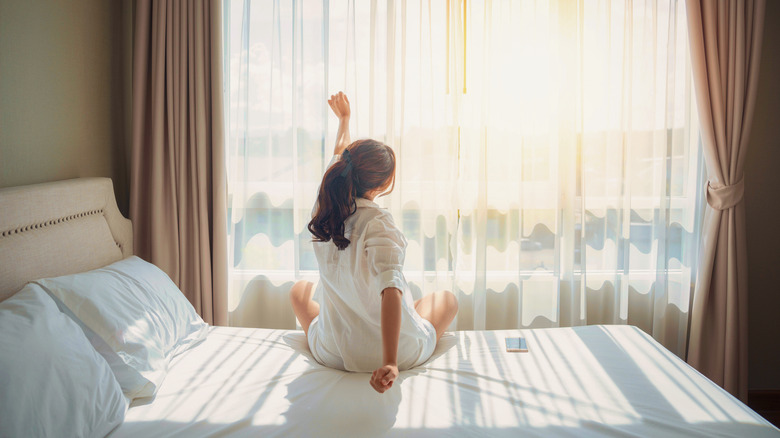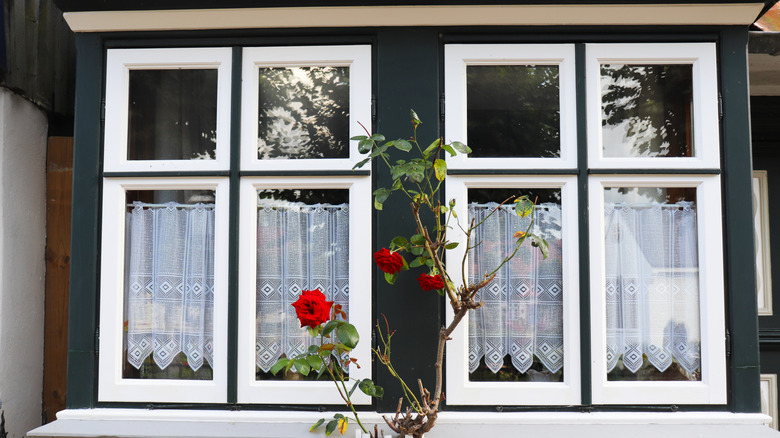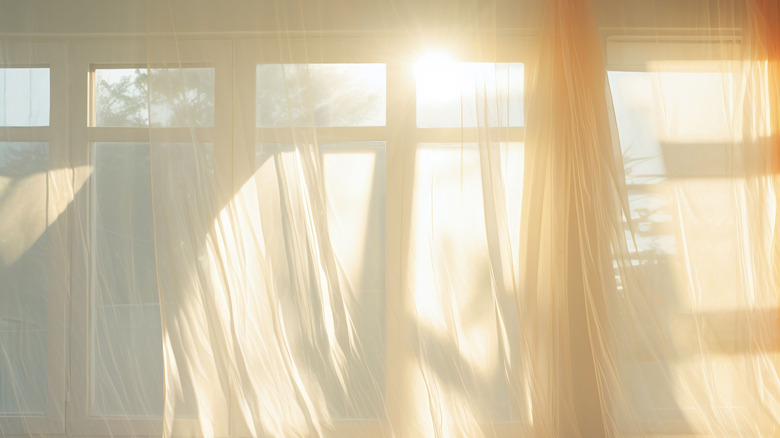The Most Durable Curtain Fabrics To Use If You Have A Sunny Room
Dressing our windows is one of the little, decadent pleasures of interior design. Or, at least it can be. It can also quickly become a stressful chore when we're overwhelmed with options, or working with a room with unique needs, as is often the case in heavily sunlit spaces. This is why it's important to choose durable curtain fabrics if you have a sunny room.
We'll break down a few options to help you choose the perfect curtains for your space. A style that will complement your space and design, provide the thermal and light mitigation necessary, and take sustainability and durability considerations into account are all facts that will enable you to have the window dressings of your dreams.
Natural, sustainable materials like wool, linen, bamboo, and hemp are among the most durable, and rank high in terms of the longevity of your drapes. However, if your priority consideration is exclusively the resilience of your curtains against the damaging rays of the sun, a synthetic option like polyester or a polyester blend may be the right way to go. They aren't as susceptible to the photodegradation that occurs more easily in naturally occurring fibers. However, that doesn't mean they won't break down or fade. If you've ever been in a home that hasn't been redecorated since the 1950s, you know what many years of sun can do to polyester curtains. There is, however, a dark side that comes along with synthetic materials, as they are much harder on the environment — both the one outside your door and the one inside your home.
The downside of synthetic curtains
Microplastics shed from synthetic materials turn up in our water sources, our food, and even our lungs. Perhaps worse still, artificial fiber curtains are often treated with fire and stain resistant chemicals that continue to off-gas over time and affect our health.
Of course, we want the products we buy for our home to last. And in a particularly sun-drenched part of the house, durable window coverings are essential. However, in the most literal sense, plastic-based and other synthetic fibers stay around for centuries — which is likely a lot longer than we really need our curtains to last. Besides, who doesn't like to update their style once every decade or so? Adding a liner to your eco-friendly drapery will extend its life even further. Plus, when the time comes to change them out, you can always find some smart ways to repurpose old curtains. So if you're looking to embrace your inner biophiliac and find the perfect, sustainable fabric options for your curtains with super-durable materials, it's worth exploring the wide array of options at your disposal.
Why sun is damaging to curtains
The reason that natural fibers don't last as long as the synthetics is because the UV light streaming through your windows is also initiating a chemical reaction deep in the fibers of your drapes. Moisture that is inherent there is reacting with the oxygen in the environment and creating hydrogen peroxide — a bleaching agent. This, of course, breaks down the fibers over time, making them even more delicate. Some fabrics are more susceptible to this process than others. While cotton doesn't take the exposure as well, bamboo fabric holds up much better.
Bamboo fabric — as opposed to slats of bamboo — can have a satin-like texture, making it a dreamy fabric to use for your drapes. It may be a good idea to check the material specifications closely when shopping. The term "bamboo" may be used in the title or description but the fabric may actually be a synthetic blend. Another option would be to simply turn bamboo bed sheets into beautiful curtains.
Real, 100% wool curtains may be toe-ing up to the "luxury item" price range and could require some intentional searching. The price, however, may be justified when you consider that the material is naturally fire-retardant, anti-microbial, and hypoallergenic. In fact, those qualities combined with its durability make it a common choice for high-end upholstery. But it isn't the only fabric that comes with a laundry list of other meritorious attributes that can help you design your home with sustainable materials.
What other natural fabrics make good curtains
Hemp fabric is also naturally sustainable, renewable, insulative, and UV resistant making it an ideal choice for durability in super sunny rooms. Its price point is perhaps more accessible than wool, but because this material is still somewhat new to the market and not widely produced, it may take some searching to find genuine, 100% hemp material.
Linen is another of our top choices for long lasting curtain fabrics. Widely lauded for its durability, linen also has the exemplary characteristic of being a zero-waste material, meaning literally every part of the plant is used and nothing is wasted. However, the material itself is not especially opaque. If heat management or photodegradation mitigation are your top priorities, perhaps getting creative with layering your curtains would be useful. In truth, most curtain materials will require some kind of blackout liner to entirely block the sunlight, though there are some wonderful blackout curtain alternatives that won't break the bank.
We all love a sun-lit home, but whether to achieve better sleep, manage the interior temperature, or reduce dust and other particulates, managing a sunny space with drapery is an indispensable part of an efficient house. They can also be a lovely part of your overall design, as they marry form and function and bring your own unique personality to the space. And, when they are done right, you will be proud to make your curtains the focus of your décor.



